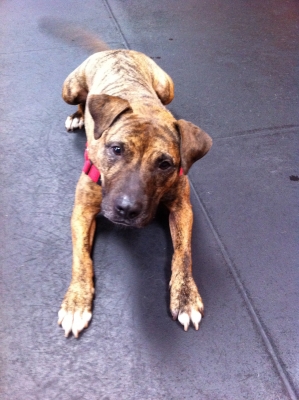Study in Leash Reactivity – Video 1 Brandi

Here is the link to the video for this blog http://youtu.be/a4kHsaUSylQ
Many dogs suffer from leash reactivity. Just many have various reasons for their reactive behavior. Additionally many dogs are a mix of fearful and frustrated and or have never been counter conditioned.
Due to their history reacting on leash and perhaps some type of sloppy application of compulsion "training" and or food rewards the humans have failed, and the reactivity has been the only real reinforcement for the dog’s feelings about stimulus in the environment.
This is the first video of many to start addressing leash reactivity. By understanding what it is we are looking for as training criteria we can have a better idea of what to train and when.
Brandi has made great progress since this filming in July 2011. We have 4 more to edit and plan on filming a recent update.
We have also been working in conjunction with board certified veterinary behaviorist Dr. Emily Levine.
The aim of this video and the one’s to follow of Brandi and other dogs is to help dogs, their owners and dog handlers have less stress and more success in the area of leash reactivity, fear and anxiousness on leash.
The main things I have found to work with leash reactive dogs are the following:
Walk a hungry dog
Have high value food rewards
Make sure you are aware of the whole environment
Know your dog’s distances and thresholds
Know you dog’s triggers
Know your dog’s “bounce back” from stress / fear events.
Lure & Prompt to create distance when needed
Increase rate of reinforcement for duration of offending stimulus
Increase distance to avoid over threshold rehearsals
Manage out of situations when counter conditioning will be thwarted.
The first question that someone may ask of the video is...
“Why did you not start as far back as possible and gradually increase your distance”?
The reason is two fold.
1 – Brandi has been known to be fine at sidewalk to street length with many of her triggers with and without reinforcement.
2 – We had done a session in this location prior and though we did not film we remembered having various successes at various distances. So we were “working it out” on film to a certain extent.
We adjusted as needed and as you will see the number of under threshold responses to triggers won out and Brandi was relaxed about the whole affair despite a few over threshold responses.
Brandi also lives a lifestyle that requires her to be out and about with sudden environmental contrasts. So we are training based on her history and what she and my client will need going forward.
Having two dogs myself that were at one time prone to very bad leash reactivity, now only our female APBT is slightly dog reactive in a few specific contexts, I know all too well the work involved.
Achieving a 90 – 95% success rate takes work, luck, skills and lots of planning. Be patient!
Even the best animal trainers have difficulty training in “open environments”. Make as much of a plan before you get out on the walk. That will help.
100% is not reasonable. Nothing in life is perfect. The goal with leash reactive dogs is to decrease to the highest possible level and work proactively to socialize and desensitize the dog as much as possible. If you get 100% reduction in reactivity please post your film of before and after and the protocols used. Would love to see it.
Having a plan and a reasonable set of goals will allow more success and less stress!
Have fun, be safe and film your training and record your data!
If you have questions, post up here at DSD, email me or respond on Facebook. Thanks!
Drayton Michaels, CTC www.pitbullguru.com




